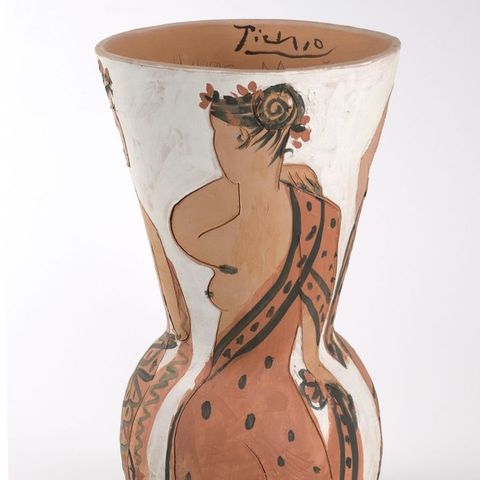
Contacts
Info
In Vallauris, Pablo Picasso had the good fortune to meet the Ramié family, who were able to satisfy his curiosity and creative flair. From the summer of 1947 Picasso investigated...
show more
In Vallauris, Pablo Picasso had the good fortune to meet the Ramié family, who were able to satisfy his curiosity and creative flair. From the summer of 1947 Picasso investigated the possibilities of ceramics, integrating and alternating form and decoration, using the sculptural quality of earth combined with pictorial data to create almost illusionistic effects as in the large vase The Four Seasons, a gift from the artist to the Museum. In this work the sinuous forms of the female figures are emphasized by the outline of the vase. In Picasso’s ceramics one can trace the fascination of Greek and classical art, but also pre-Columbian art, the path of primitive rock graffiti, in a sort of homage and reverence for the great civilizations that have measured themselves against ceramics.
show less

11 APR 2022 · In Vallauris, Pablo Picasso had the good fortune to meet the Ramié family, who were able to satisfy his curiosity and creative flair. From the summer of 1947 Picasso investigated the possibilities of ceramics, integrating and alternating form and decoration, using the sculptural quality of earth combined with pictorial data to create almost illusionistic effects as in the large vase The Four Seasons, a gift from the artist to the Museum. In this work the sinuous forms of the female figures are emphasized by the outline of the vase. In Picasso’s ceramics one can trace the fascination of Greek and classical art, but also pre-Columbian art, the path of primitive rock graffiti, in a sort of homage and reverence for the great civilizations that have measured themselves against ceramics.
In Vallauris, Pablo Picasso had the good fortune to meet the Ramié family, who were able to satisfy his curiosity and creative flair. From the summer of 1947 Picasso investigated...
show more
In Vallauris, Pablo Picasso had the good fortune to meet the Ramié family, who were able to satisfy his curiosity and creative flair. From the summer of 1947 Picasso investigated the possibilities of ceramics, integrating and alternating form and decoration, using the sculptural quality of earth combined with pictorial data to create almost illusionistic effects as in the large vase The Four Seasons, a gift from the artist to the Museum. In this work the sinuous forms of the female figures are emphasized by the outline of the vase. In Picasso’s ceramics one can trace the fascination of Greek and classical art, but also pre-Columbian art, the path of primitive rock graffiti, in a sort of homage and reverence for the great civilizations that have measured themselves against ceramics.
show less
Information
| Author | MIC Faenza |
| Organization | MIC Faenza |
| Categories | Arts |
| Website | - |
| info@micfaenza.org |
Copyright 2024 - Spreaker Inc. an iHeartMedia Company
